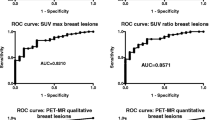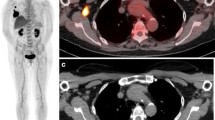Abstract
Positron emission tomography (PET) using fluorine-18 2-deoxy-2-fluoro-d-glucose (FDG) is of potential value for the diagnosis of malignant tumours. The aim of this study was to evaluate the use of FDG PET in patients with breast tumours, appraising its applicability in visualising primary carcinomas and regional metastases in a clinical setting. Results of FDG PET were compared with those of mammography, breast ultrasonography and histology in 30 patients with inconclusive breast findings. For PET, transmission and emission images were taken in one or two scan positions, depending on the available time and the clinical status of patients. PET showed focal FDG uptake with high contrast in 21 of 23 primary carcinomas. In one patient, only PET correctly visualized multifocal disease (three foci, Ø 0.4–1 cm). The accuracy of PET in the detection of primary breast cancer was 90%, and in the detection of involved axillary lymph nodes, 94%. All metastases (lymph nodes, lungs, bones, soft tissues) covered by the field of view and demonstrated by other methods (X-ray, computed tomography, magnetic resonance imaging, bone scan) showed FDG uptake. In three patients, only PET initiated further diagnostic procedures. The results indicate that FDG PET can provide a rapid diagnostic study (45–60 min) and allows accurate tumour staging of several organ systems for primary tumour and metastases with a single imaging study in a routine clinical setting.
Similar content being viewed by others
References
Warburg O. On the origin of cancer cells.Science 1956; 123: 309–314.
Strauss LG, Conti PS. The application of PET in clinical oncology.J Nucl Med 1991; 32: 623–664.
Pietrzyk U, Scheidhauer K, Scharl A, Schuster A, Schicha H. Presurgial visualization of primary breast carcinoma with PET emission and transmission imaging.J Nucl Med 1995; 36: 1882–1884.
Adler LP, Crowe JP, al Kaisi NK, Sunshine JL. Evaluation of breast masses and axillary lymph nodes with (F-18)-2-deoxy2-fluoro-d-glucose PET.Radiology 1993; 187: 743–750.
Glaspy JA, Hawkins R, Hoh CK, Phelps ME. Use of positron emission tomography in oncology.Oncology-Huntigt 1993; 7: 41–52.
Wienhard K, Eriksson L, Grootoonk S, Casey M, Pietrzyk U, Heiss WD. Performance evaluation of the position scanner ECAT EXACT.J Comput Assist Tomogr 1992; 16: 804–813.
Hamacher K, Coenen HH, Stöcklin G. Efficient stereospecific synthesis of no-carrier-added 2-(18F)-fluoro-2-deoxy-d-glucose using aminopolyether supported nucleophilic substitution.J Nucl Med 1986; 27: 235–238.
Pietrzyk U, Herholz K, Heiss WD. Three-dimensional alignment of functional and morphological tomograms.J Comput Assist Tomogr 1990; 14: 51–59.
Pietrzyk U, Herholz K, Fink G, Jacobs A, Mielke R, Slansky J, Würker M, Heiss WD. An interactive technique for threedimensional image registration: validation for PET, SPECT, MRI, and CT brain studies.J Nucl Med 1994; 35: 2011–2018.
Wahl RL, Cody RL, Hutchins GD, Mugett EE. Primary and metastatic breast carcinoma: initial clinical evaluation with PET with the radiolabeled glucose analogue 2-(F-18)-fluoro2-deoxy-d-glucose.Radiology 1991; 179: 765–770.
Lichter AS, Adler DD, August DA, Honig SF, Lippmann ME, Schottenfeld DA. Breast Cancer. In: Hoskins JW, Perez CA, Young RC, eds.Principles and practice of gynecologic oncology. Philadelphia: Lippincott; 1992: 827–891.
Minn H, Leskinen-Kallio S, Lindholm P, Bergman J, Ruolsalainen U, Teras M, Haaparanta M. (18F)-fluorodeoxyglucose uptake in tumours: kinetic vs. steady-state methods with reference to plasma insulin.J Comput Assist Tomogr 1993; 17: 115–123.
Wahl R, Henry C, Ethier S. Serum glucose: effects on tumour and normal tissue accumulation of 2-(F-18)-fluoro-2-deoxy-d-glucose in rodents with mammary carcinoma.Radiology 1992; 183: 643–647.
D'Orsi C. To follow or not to follow, that is the question.Radiology 1992; 184: 306.
Kopans D. The accuracy of mammographic interpretation.N Engl J Med 1994; 331: 1521–1522.
Elmore J, Wells C, Lee C, Howard D, Feinstein A. Variability in radiologists' interpretation of mammograms.N Engl J Med 1994; 331: 1493–1499.
Kopans D. Breast imaging and the standard of care for the symptomatic patient.Radiology 1993; 187: 608–611.
Varas X, Leborgne F, Leborgne JH. Nonpalpable, probably benign lesions: role of follow-up mammography.Radiology 1991; 179: 463–468.
Sickles EA. Periodic mammographic follow-up of probably benign lesions: results in 3,184 consecutive cases.Radiology 1992; 184: 409–414.
Author information
Authors and Affiliations
Rights and permissions
About this article
Cite this article
Scheidhauer, K., Scharl, A., Pietrzyk, U. et al. Qualitative [18F]FDG positron emission tomography in primary breast cancer: clinical relevance and practicability. Eur J Nucl Med 23, 618–623 (1996). https://doi.org/10.1007/BF00834522
Received:
Revised:
Issue Date:
DOI: https://doi.org/10.1007/BF00834522




